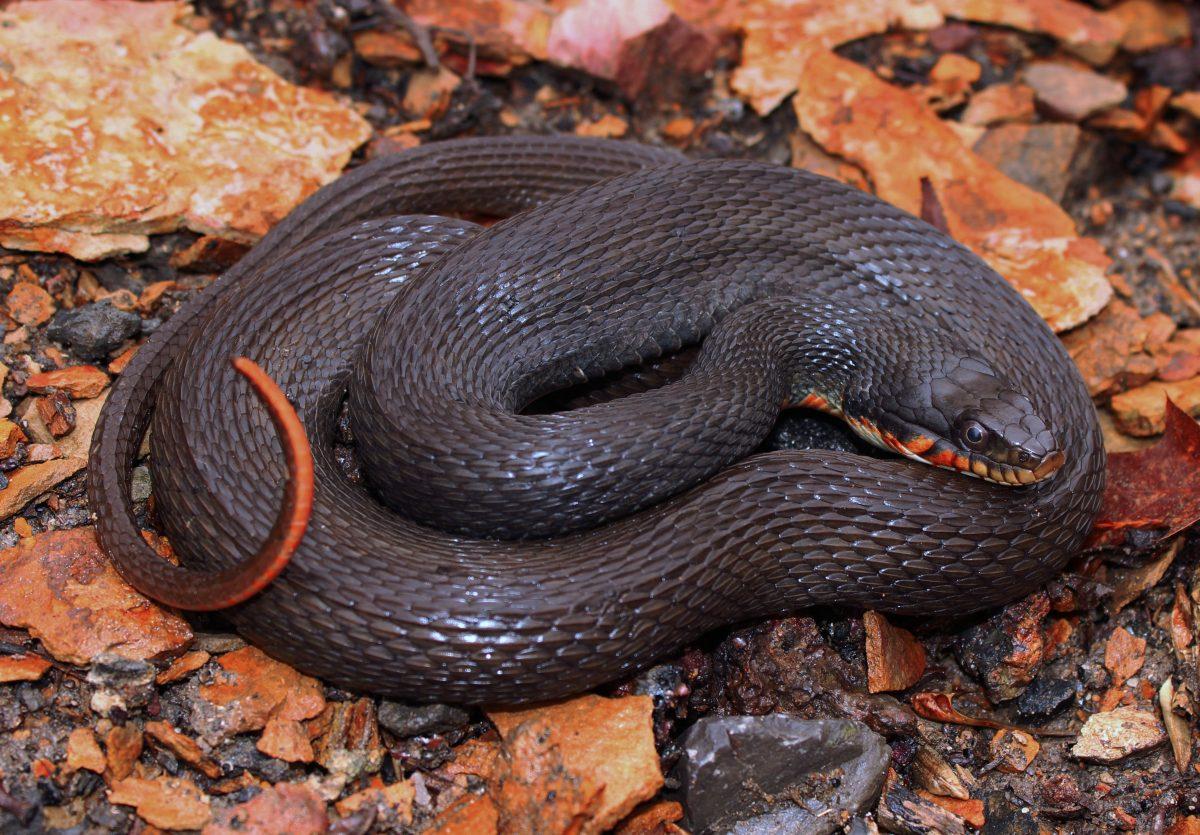
Copper-Bellied Watersnake // Peter Paplanus via Flickr
NOT AS COMMON AS A PENNY. Copper-Bellied Watersnakes are one of the state-endangered snakes in Indiana. Southern Michigan and Northern Indiana and Ohio are the habitats of this snake.
By: Ashley Bergeron
Staff-Writer
Snakes are known to be feared and dangerous due to a few venomous species (or just because their slithering might make you uneasy). While some species are potentially dangerous to humans, many are not. Venomous or not, snakes are very important for the ecosystem and are important for understanding certain studies of biology. Let’s learn about them!
Snakes are under the suborder Serpentes, which is part of the order Squamata. This order includes other reptiles like lizards. There are more than 3,400 species of snakes found on the Earth on all continents except Antarctica. No snake species is natively found in Iceland, Ireland, Greenland or New Zealand. There are about 600 venomous species, accounting for about 18% of all snake species. Out of those 600, roughly 200 are dangerous to humans.
 Timber Rattlesnake // Brad Carlson via FlickrNOT YOUR SPIDEY’S VENOM. Timber Rattlesnakes are one of the four venomous snakes in Indiana alongside Copperheads, Cottonmouths and Eastern Massasauga Rattlesnakes.
Timber Rattlesnake // Brad Carlson via FlickrNOT YOUR SPIDEY’S VENOM. Timber Rattlesnakes are one of the four venomous snakes in Indiana alongside Copperheads, Cottonmouths and Eastern Massasauga Rattlesnakes.
To figure out if a reptile is a snake, see if it is limbless, has a greatly elongated body and tail, has no moveable eyelids and has external ear holes.
Snakes are unique in the reptile world, as they have no limbs. This is due to a loss of the ZRS limb-enhancer gene sequence, which is found in limb-forming animals. Primitive snakes like boas have a shorter sequence, whereas advanced species have completely lost the sequence altogether.
Snakes have an organ used for chemoreception – detecting chemicals in the environment – called Jacobson’s organ. It appears in many tetrapods like crocodiles, turtles, cetaceans, birds and primates during the embryonic stage, but it is significantly reduced or absent in adulthood.
Using their forked tongue, snakes can carry odor particles from the top of the tongue to the openings. After these particles reach the organ, some of the compounds bind to receptors and a message is sent to the brain. These compounds can help the individual find a potential sex mate and hunt for their next meal.
The lower jaw bones, or mandibles, in snakes, are loosely connected to the skull, resulting in them being able to make their mouth bigger than their body. Instead of a jaw built for brute force, snakes’ jaws are implemented with tendons, muscles and ligaments that create flexibility, allowing them to swallow hefty prey.
Venomous snakes can control how much venom they can put into their bite depending on prey size, level of threat and other factors. This isn’t an innate ability, meaning that younger snakes will not control their venom, resulting in their bites having the highest amount of venom. As they get more experience, the little ones will learn how to control their venom so that they don’t waste any precious resources.
According to the Indiana Department of Natural Resources (DNR), in Indiana, there are 32 species of snakes in Indiana, with only four of them being venomous:
Copperhead: only found in the southern half of the state
Cottonmouth (State Endangered): only found in one small area in southwestern Indiana
Eastern Massasauga Rattlesnake (Federally Threatened): Northern Third of Indiana
Timber Rattlesnake (State Endangered): South Central Indiana
 Gartersnake // Eric Bégin via FlickrWHAT THE FORK?! Snakes used their forked tongue to pick odor particles to take to one of the two openings of their Jacobson’s organ, giving them information about their environment like the location of prey.
Gartersnake // Eric Bégin via FlickrWHAT THE FORK?! Snakes used their forked tongue to pick odor particles to take to one of the two openings of their Jacobson’s organ, giving them information about their environment like the location of prey.
Some non-venomous snakes that are state-endangered include Butler’s Gartersnake, Copper-Bellied Water Snake, Kirtland’s Snake, Smooth Greensnake, Scarlet Snake and Southeastern Crowned Snake.
Snakes eat various animals, like rodents, insects, birds, frogs, salamanders, slugs and other snakes. Snakes are also prey for raccoons, coyotes, cats, hawks, eagles and other snakes.
They’re important for the ecosystem, as they can keep their prey populations under control while also being a meal for other organisms. Also, their moltings can enrich the soil, keeping the nutrients flowing in the ecosystem.
The biggest threats to snakes are habitat loss, death by humans, pesticides and collection of wild snakes from collectors and reptile dealers.
If you want to own a pet snake, make sure you know where the snake came from. Is it from a breeder, or is it a rescue? If it’s neither, stay away, as the seller might have yanked the snake out of its habitat.
Coming across a snake can always be a little scary; you don’t know if they’re venomous or not. But snakes are usually threatened by humans, which is why they bite us in the first place. If you see a snake in the wild, leave it alone and you won’t get bitten.
If you are interested in learning more about snakes around the IU South Bend area, check out southbendsnakes.com. If you are interested in helping protect endangered snake species, check out savethesnakes.org.